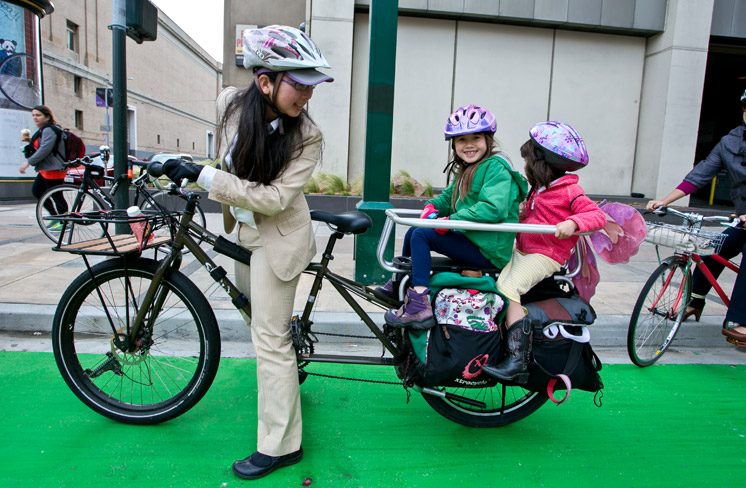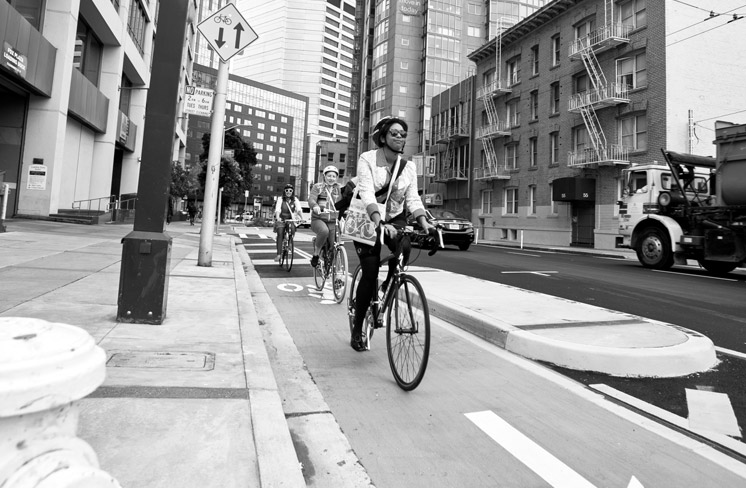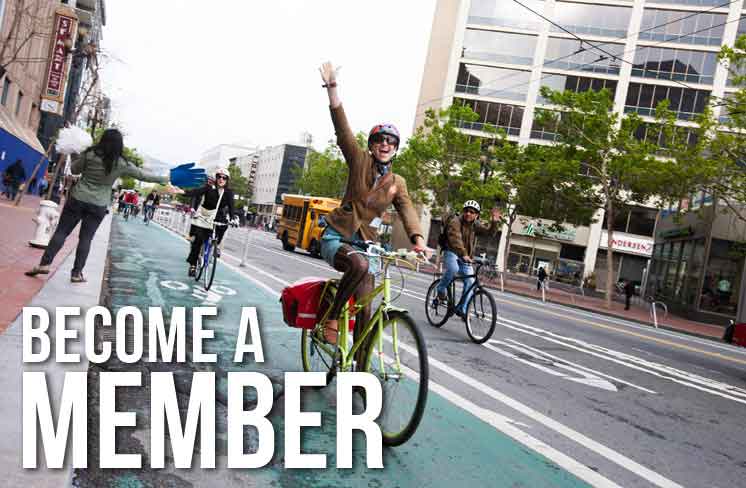The Lower Polk Street protected bikeway opened with fanfare — a ribbon cutting, cheering onlookers, a cadre of local media snapping photos and dozens of City leaders taking part in the inaugural ride.
Standing next to the fresh green bikeway, DPW Director Muhammed Nuru proclaimed, “Our city is moving in the right direction.” Supervisor Jane Kim stated, “This is the kind of bike lane that will get me out of a car and onto a bike.” And SF Bicycle Coalition member Shannon Dodge said simply, “This is going to transform my commute.”
Why was there so much hubbub for a three-block project? Quite simply: the Polk Street bikeway is a game-changer for our city. With the Polk contraflow bikeway, we have a project that we can point to and say, “this is what we’re talking about.”
A Key Crosstown Bikeway
The Lower Polk Street bikeway fills in a key link in our Connecting the City vision of 100 miles of crosstown bikeways that link your home to your work and everywhere in between.
Polk Street is the backbone of Connecting the City’s north/south bikeway. As the flattest route, Polk Street is a natural connector between City Hall and the Marina. Your SF Bicycle Coalition is busy working on getting protected bikeways the full length of Polk Street, and this lower section is a great start. The new bikeway fills in a critical gap by safely connecting two of our busiest bikeways: Market and Polk Streets.
Before the Lower Polk Street bikeway was completed, if you wanted to ride from Market Street to Polk Street business district or to City Hall, you had brave Van Ness Avenue, a freeway, or ride on the sidewalk, which is illegal. The new bikeway (called a contraflow because it goes against the flow of car traffic) eliminated both of those terrible options, providing a clear connector between bustling bikeways.
There are still lots of gaps in our network, and your SF Bicycle Coalition is working to fill those. From multi-block gaps to issues of light timing to streets and bikeways in need of repaving, we’re working on all the fronts to make your ride more comfortable.
This year, we worked closely with the SFMTA to come up with a list of key spot improvements to tackle first, and we’re glad to see projects like the Duboce/Market intersection already improved. Contribute your own spot improvement suggestions here.
The Importance of Good Design
A beautiful, inviting design is what separates the Polk Street bikeway from the other handful of protected bikeways in the city. The bikeway itself is physically separated from car traffic with a curb and landscaped median filled with succulents.
An appealing design like this is important in winning support for more bike projects. Connecting the City with crosstown bikeways requires buy-in from residents and business owners – it’s why SF Bicycle Coalition staff and member-leaders attend countless community meetings and walk door to door to explain the broad value of projects. Recognizing that bike projects are also traffic calming and street beautification projects goes a long way in creating community and business support.
The Polk Street design stands in stark contrast to other protected bikeways in the city (like Market Street), which are primarily offset by white soft-hit posts that are often run over or damaged by illegally parked vehicles. We’re pleased to say that the white posts on the Fell and Oak Streets bikeways will be replaced with large planters and greenery soon, and our Market Street vision includes permanent and continuous separation for bikes.
Not Just for Bikes
The Polk project is part of the next generation of bikeways —projects that don’t just benefit bike riders, but clearly benefit all road users. Protected bikeways make order out of chaos, creating clear delineation for all road users. People on bikes feel safer with separation from cars; people driving don’t have to worry about hitting someone on bike; and people walking have a buffer between the sidewalk and street, providing a calmer environment and reducing the distance they have to walk across busy streets.
What’s Next?
There are more bike projects like the one on Lower Polk Street underway. In June, the City implemented the long-awaited San Jose Avenue pilot, adding a buffered bikeway to this previously chaotic street, creating a calmer commute for thousands of people who bike here every day. Posts and green paint are coming to that stretch soon. In 2015, the Masonic Avenue boulevard project will break ground, consisting of raised bikeways and a planted median with 100 new trees. Change is underway across the city!
We’re thrilled to see 8-to-80 projects like the Lower Polk Street, Fell and Oak Streets and San Jose Avenue bikeways in the ground. The vision for a truly connected city is starting to take shape. Thank you to all of our members, volunteers and community groups who have helped champion these protected bikeways. Together, we are Connecting our City!
Get more involved with our Connecting the City campaigns.



